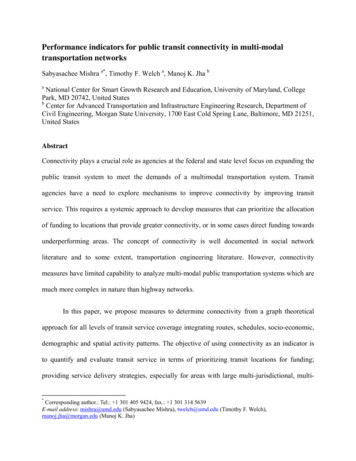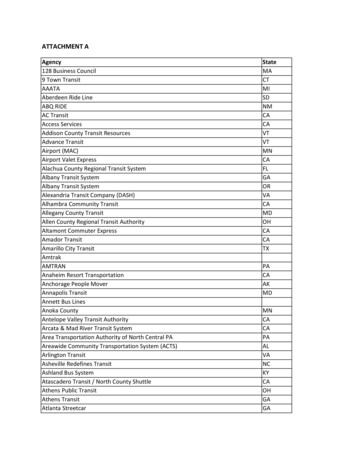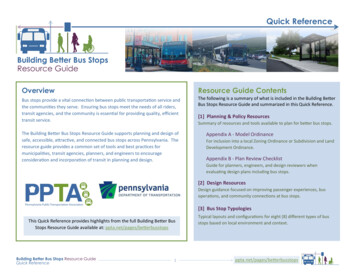
Transcription
Performance indicators for public transit connectivity in multi-modaltransportation networksSabyasachee Mishra a*, Timothy F. Welch a, Manoj K. Jha baNational Center for Smart Growth Research and Education, University of Maryland, CollegePark, MD 20742, United StatesbCenter for Advanced Transportation and Infrastructure Engineering Research, Department ofCivil Engineering, Morgan State University, 1700 East Cold Spring Lane, Baltimore, MD 21251,United StatesAbstractConnectivity plays a crucial role as agencies at the federal and state level focus on expanding thepublic transit system to meet the demands of a multimodal transportation system. Transitagencies have a need to explore mechanisms to improve connectivity by improving transitservice. This requires a systemic approach to develop measures that can prioritize the allocationof funding to locations that provide greater connectivity, or in some cases direct funding towardsunderperforming areas. The concept of connectivity is well documented in social networkliterature and to some extent, transportation engineering literature. However, connectivitymeasures have limited capability to analyze multi-modal public transportation systems which aremuch more complex in nature than highway networks.In this paper, we propose measures to determine connectivity from a graph theoreticalapproach for all levels of transit service coverage integrating routes, schedules, socio-economic,demographic and spatial activity patterns. The objective of using connectivity as an indicator isto quantify and evaluate transit service in terms of prioritizing transit locations for funding;providing service delivery strategies, especially for areas with large multi-jurisdictional, multi-*Corresponding author.: Tel.: 1 301 405 9424, fax.: 1 301 314 5639E-mail address: mishra@umd.edu (Sabyasachee Mishra), twelch@umd.edu (Timothy F. Welch),manoj.jha@morgan.edu (Manoj K. Jha)
modal transit networks; providing an indicator of multi-level transit capacity for planningpurposes; assessing the effectiveness and efficiency for node/stop prioritization; and making auser friendly tool to determine locations with highest connectivity while choosing transit as amode of travel. An example problem shows how the graph theoretical approach can be used as atool to incorporate transit specific variables in the indicator formulations and compares theadvantage of the proposed approach compared to its previous counterparts. Then the proposedframework is applied to the comprehensive transit network in the Washington-Baltimore region.The proposed analysis offers reliable indicators that can be used as tools for determining thetransit connectivity of a multimodal transportation network.Key Words: public transportation, connectivity, graph theory, multimodal transit network2
1. IntroductionTransit networks consist of nodes and lines to represent their layout. The nodes are called stopsand the lines are called links or route segments. Links in a multimodal transit network havedifferent characteristics from those in a road network. While link in a road network is a physicalsegment that connects one node to another, link of a multi-modal transit network is part of transitline that serves a sequence of transit stops (nodes). Since a stop can be served by different transitlines, multiple transit links may exist between nodes in a multi-modal transit network. But in thecase of a highway network only one link exists between two nodes. Headway, frequency, speed,and capacity are critical terms that define the characteristics of a route for a transit link.Similarly, transit nodes are composed of a different set of characteristics than highway nodes.The nodes and links of the transit system are synonymous with the analysis of connectivity ingraph theory (Harary 1971). Graphs more or less connected are determined from two invariantssuch as node and line connectivity.Determining the level of service of a transit network is a difficult task. There are twoprincipal reasons. First, the number of factors related to service quality, such as walking distance,in-vehicle travel time, waiting time, number of destinations served and number of transfersneeded to reach destinations makes transit connectivity a multidimensional problem. Second, thetransit system consists of many different routes. Determining the extent to which the routes areintegrated and coordinated so that the transit system is connected, is another complex task (Lamand Schuler 1982). The structure of the public transit network is critical in determiningperformance, coverage, and service of the network. Network connectivity can be used as ameasure to study the performance of the transit system which will assist decision makers inprioritizing transit investment and deciding which stops/lines need immediate attention in regard3
to operation and maintenance (Hadas and Ceder 2010). In this context, connectivity is one of theindex measures that can be used to quantify and evaluate transit performance (Borgatti 2005).Measures of transit connectivity can be used for a number of purposes. First, in a publicor quasi-public agency, connectivity can be used as a measure in public spending to quantifytransit stop and route performance and to evaluate the overall system performance. Second, in arural or suburban area where exact information on transit ridership, boardings, and alightings arenot available (which are generally obtained from a comprehensive and well-designed transitassignment in a travel demand model or from an advanced transit system where smart cards areused to keep track of revenues) to obtain a measure of performance for developing servicedelivery strategies. Third, to serve as a performance measure in a large scale urban multi-modaltransit network containing local buses, express buses, metro, local light rail, regional light rail,bus rapid transit, and other transit services which serve both urban and rural areas, where transitservices are provided by different public and private agencies with little coordination (anexample being Washington DC-Baltimore area, with more than 18 agencies providing services).Fourth, to provide an assessment of effectiveness and efficiency of a transit system withquantifiable measures that can be used to prioritize the nodes/links in a transit system,particularly in terms of emergency evacuation. Fifth, to assist transit agencies with thedevelopment of a set of tools for the potential transit users to assess the level and quality oftransit service at their place of residence or work.This paper proposes a unique approach to measuring transit connectivity, particularly forapplications where the use of transit assignment models or ridership tracking tools is notavailable. This method incorporates a graph theoretic approach to determine the performance oflarge-scale multimodal transit networks to quantify the measures of connectivity at the node,4
line, transfer center, and regional level. This is achieved through an assessment of connectivitythat incorporates unique qualities of each transit line and measures of accessibility. Bycombining these criteria in a single connectivity index, a quantitative measure of transitperformance is developed that goes beyond the traditional measure of centrality. The newconnectivity index significantly extends the set of performance assessment tools decision makerscan utilize to assess the quality of a transit system.The next section presents the literature review indicating the use of connectivity in pastresearch, followed by the objective of research showing the scope of improvement in existingliterature. The methodology section describes a step by step process of obtaining transitconnectivity. An example problem is then presented demonstrating various connectivity indexes.A case-study shows how the concept can be applied in real world applications. The next sectionshows results of the case study. Finally, findings of the study are discussed in the conclusionsection.2. Literature ReviewCentrality measures are well studied in the literature. However, their application to public transitis rare. Table 1 represents a summary of connectivity index measures (or derivatives thereof)found in the literature. The first measure in Table 1 is degree of centrality. The total number ofdirect connections a node has to other system nodes is defined as the degree centrality. Equation(1) suggest that the degree of centrality of a nodein a larger network “N” is the sum ofthe number of links originated from “p” number of nodes crosses through node “n” (p represents all nodes except n (i.e. ), where). This measure is then normalized by dividingby the total number of system nodes N minus 1. Equation (2) represents a conditional statement5
to support the degree centrality, whererepresents a binary indicator variable which takes thevalue 1, if node “p” is incident upon node “n”, and 0 otherwise. Degree centrality is the mostwidely used measure of connectivity in the literature which ranges from transportation tocomputer science to epidemiology (Martínez et al. 2003; Liu et al. 2005; Bell, Atkinson, andCarlson 1999; Junker, Koschutzki, and Schreiber 2006; Guimerà et al. 2005). Table 1 about here The degree centralitysimply counts the number of direct connections a node has toother nodes in the network, but does not account for the quality of the connection or indirectaccessibility to other nodes. Eigenvector centrality acknowledges that not all connections areequal. It assigns relative ‘scores’ to all nodes in the network based on the principle thatconnections to high-scoring nodes contribute more to the score of the node in question than equalconnections to low-scoring nodes. The eigenvector centralityof node n, in the network N(n, l), is defined in equation (3), which is the multiplication of degree centrality toscaled by the eigenvalue . Degree centrality (, and) is the eigenvector in equation (3). Theeigenvector centrality succeeded the development of degree centrality and is used for a numberof studies.As defined by Freeman (1979), a node’s closeness centrality is the sum of graph-theoreticdistances from all other nodes, where the distance from a node to another is defined as the length(in links) of the shortest path from one to the other. Equation (4) shows the formulation forcloseness centrality. Nodes with low closeness scores have short distances from others, and willtend to be more accessible. In topology and related areas in mathematics, closeness is one of thebasic concepts in a topological space.6
Betweenness centrality is defined as the share of times that a node n1 needs a node n(whose centrality is being measured) in order to reach a node n2 via the shortest path. Equation(5) shows the formulation for betweenness centrality. Alternatively, betweenness centralitybasically counts the number of geodesic paths that pass through a node n. The denominator existsto address the case where there are multiple geodesics between n1 and n2, and node n is onlyalong some of them. Hence, betweenness is essentially n’s share of all paths between pairs thatutilize node n—the exclusivity of n’s position.Previous node indexes did not take into account transit characteristics. Park and Kang(2011) introduced the transit characteristics into the node centrality measures and proposed theconnectivity index as a true measure of a transit node. The connectivity index of a node can bedefined as the sum of connecting powers2 of all lines crossing through a node n. The connectivityindex is shown in equation (6). The total connecting power of a node is the multiple ofconnecting power of a line at node n (.represented by a binary indicator variable (). The conditional value of presence of a line is,), which takes the value 1 if line l contributes tothe connectivity at node n, and 0 otherwise. The characteristics of a link contain the performanceof a series of nodes in that link. A link is a part of the transit route, which in turn is a function ofthe speed, distance, frequency, headway, capacity, acceleration, deceleration, and other factors.Since a route will contain both in-bound and out-bound, the line performance will in part dependupon the directionality of the transit route, that is, whether the line is circular or bidirectional.The total connecting power of line l at node n is the average of outbound and inboundconnecting power and can be defined as2Please refer to equation (9) in Table 1 for the formulation of connecting power.7
,,(6.1),2The outbound connecting power of a line l, at node n can be defined as (Park and Kang 2011)60,is the average vehicle capacity of line l,where,divided byline l,to determine the number of operation per hour),is the speed of line l, andparameter,,(6.2)is the frequency on line l (60 isis the daily hours of operation ofis the distance of line l from node n to the destination. Theis the scaling factor coefficient for capacity which is the reciprocal of the averagecapacity of the system multiplied by the average number of daily operations of each line,is thescaling factor coefficient for speed represented by the reciprocal of the average speed on eachline, andis the scaling factor coefficient for distance which is the reciprocal of the averagenetwork route distance. Similarly, the inbound connecting power of line l can be defined as60.where,.,(6.3)is the inbound connecting power of line l at node n. While the outboundconnecting power of a transit line at a certain transit stop represents connectivity from the stop tothe downstream stops of the transit line, the inbound connecting power measures connectivityfrom the upstream stops of the transit line to the stop under consideration.Analyzing connectivity of transfer centers is critical to exploring the performance of acombination of several transit stops through which passengers change their mode oftransportation. Level of service is one of the critical measures that determine the performance of8
the transfer center. Equation (7) represents the connectivity index of a transfer center. Where,,is the passenger acceptance rate and is defined as(7.1),,where, a and b are the parameters of passenger acceptance rate, and,is the transfer time totravel from node n1 to n. The parameters for a and b are assumed from Kim and Kwon (2005)and estimated based on model estimation which found that walk time provided an R-square valueof .9846; that is, walk time alone explained 98.46 percent of the passenger transfer acceptancerates.Similarly, the connectivity index of a region (equation 8) can be defined as the sum ofconnectivity indexes of all nodes and scaled by the density measure, whereis a densitymeasure of region R. The density could be a measure in population, employment, and householdin the region. The line connecting power and connectivity indexes are shown in equation (9), and(10).3. Problem Statement and ObjectivesMany measures of transit service and accessibility have been put forth in the literature, but fewoffer a metric to measure the quality of service and performance of a large multi-modal regionaltransit system. The literature that does purport to offer such insight requires significant amountsof data not only about the transit system, but also of the complete demographics of the servicearea (Beimborn et al. 2004, Modarres 2003). Other methods require a full transportation demandand transit assignment models, tools that are prohibitively expensive for many localities (Lamand Schuler 1982).9
Measuring transit system performance and the level of service at many different levels isvital to funding decisions (Dajani and Gilbert 1978). Agencies with the objective to improve thetransit system using external funds must make the case that the project will be a worthwhileimprovement to the system. At the same time, agencies interested in investigating the potentialeffect of removing a stop, group of stops or transit line from service must know the potentialeffect it will have on the performance of the system. In the absence of complex transportationdemand models, this information is nearly impossible to obtain (Baughan et al. 2009). Amethodology that reduces the need for large amounts of data, yet provides important informationon system performance is critical to the decision making process. Transit planning agencies mayalso be interested in applying such an index to determine the best use of land surrounding wellconnected transit nodes. Beyond Transit Oriented Development (TOD) style plans, theconnectivity index provides a way for planners to measure passenger acceptance rates andaccessibility for a single node based on its access within an entire multi-modal regionaltransportation network.The objectives of this paper are several fold, with the overall goal of providing a strongmeasure of system performance with the lowest possible data requirements. This paper will firstseek to construct a list of node and link based commonly encountered flow processes and definethem in terms of a few underlying characteristics; second, to determine and propose the bestsuited measures in terms of transit connectivity; third, to examine these measures by runningsimulations of flow processes and comparing the results in a real world case study; and fourth, tosuggest the best practices which can be adopted for decision making. All the aforementionedproblems require the development of a tool to quantify connectivity of a public transportation10
system. The proposed methodology is presented in the next section and the notations are shownin Appendix-I.4. MethodologyThe methodology presented in this paper is for transit systems at different levels. As the verynature of nodes, lines, transfer centers and regions, each require a unique formulation. Thedescription below explains the mathematical construct of these transit levels in a step-by-stepmanner.4.1 Node ConnectivityThe proposed methodology consists of better representations of transit node index measures. Inthe proposed formulation we consider the congestion effects achieved because of lane sharing oftransit lines of buses, light rail, bus rapid transit, and other similar transit facilities. We haveredefined the connecting power of a transit line. The other measures have not incorporated thetransit attractiveness as it relates to land use and transportation characteristics of the area theassociated with the transit line. As discussed previously, the connecting power of a transit line isa function of the inbound and outbound powers, as the connecting power may vary depending onthe direction of travel. The inbound and outbound connecting power of a transit line can beredefined as follows.,,,(11),,,(12)The addition in equation (11) is a term for activity density of transit line "l" at node "n",andis the scaling factor for the variable. The density measurement represents the developmentpattern based on both land use and transportation characteristics. The literature defines the level11
of development a number of ways, but for simplification purposes we have considered it to bethe ratio of households and employment in a zone to the unit area. Mathematically, activitydensity (equation (13)) is defined as:,,(13),Θ,The connectivity index measures aggregate connecting power of all lines that are accessible to agiven node. However not all lines are equal; nodes with access to many low quality routes mayattain a connectivity index score equal to a node with only a couple very high quality transitlines. This means that while both nodes are able to provide good access, the node with the fewestlines provides the most access with the lowest need to transfer. To scale the index scores basedon the quality of individual lines, that is, scaling for the least number of transfers needed to reachthe highest number and quality of destinations, the node scores are adjusted by the number oftransit lines incident upon the node. The inbound and outbound connecting power of a transit linecan be further refined as:,,,,(14),,,,(15)This equation adds the number to transit lines “l” at node “n”, andis the scaling factor for thenumber of transit lines. The transfer scale is simply the sum of the connectivity index scores foreach of the transit lines that cross a node divided by the count of the number of lines that areincident upon the node. The transfer scaled index (equation (13)) is defined as: ,(16),Θ12
4.2 Line ConnectivityThe total connecting power of a line is the sum of the averages of inbound and outboundconnecting powers for all transit nodes on the line as presented in equation (6.1) scaled by thenumber of stops on each line. The scaling measure is used to reduce the connecting score of lineswith many stops like bus lines to properly compare to lines with only a few stops like rail. Theline connectivity can be defined as following: 1(17),4.3 Transfer CenterThe concept of a connectivity index of a transfer center is different from the connectivitymeasure of a conventional node. Transfer centers are groups of nodes that are defined by the easeof transfer between transit lines and modes based on a coordinated schedule of connections at asingle node or the availability of connections at a group of nodes within a given distance or walktime. This paper defines a transfer center as the group of nodes within half mile of any railstation in the transit network. The sum of the connecting power of each node in the transfercenter is scaled by the number of nodes on the transfer center. Thus, a node in a heavily densearea is made comparable to the transfer center in a less dense area. This scaling procedure isparticularly important when comparing transfer centers in a multimodal network where onetransfer center may be primarily served by a well-connected commuter rail line and other mayhave many bus lines and rail lines connecting to the center. The following equation shows theconnectivity index of a transfer center. 1.13,(18)
4.4 Regional (large area) ConnectivityThe connecting power of a Region or any other large area has several important implications.The performance of a given area is the sum of the connectivity of all nodes within that areascaled by the number of nodes. This scaling makes it possible to compare the quality ofconnectivity between areas of differing density. The regional connectivity index equation isshown below. 1,(19)5. Example ProblemIn this section, the methodology is described with the help of an example problem. The examplenetwork shown in Fig. 1(a) consists of (1) ten stops, (2) five lines, (3) two transfer centers, and(4) five Traffic Analysis Zones (TAZs). Three characteristics of each line such as operatingspeed, capacity and number of operations are given. Each TAZ is attributed with a densitymeasure which is the ratio between the population and corresponding area. Table 2 shows thecomparison of the approaches reported in the literature, and the new approach, at the node, line,transfer center, and region level. In the comparison only degree centrality is obtained from theliterature, which is presented at the node level. For the line, node and transfer centerconnectivity, the related measures from the literature are analyzed in the example problem. Fig. 1(a) about here Fig. 1(b) about here 14
5.1 Node and Line LevelThe node level measures are presented in Table 2. Degree centrality of node-1 is 0.222 (i.e. 2/9),as there are two nodes incident upon node-1 (node 2, and node 5), and there are nine remainingnodes in the system (please refer to equation (1) for the formula). Similarly degree centrality forall the nodes can be determined. The connectivity index of node-1 is 1.543. This number isderived from three steps: Table 2 about here A zoomed version of node-1 is shown in Fig. 1(b). There are two lines crossing through node-1(Line-1 and Line-3). The inbound connecting power of line-1 at node-1 (.) is calculated fromequation 6.2. ,.400.where, 468.457,20.10 1.008. 20.062, and 8.437. The capacity of line-1 is 400 (i.e. 8x50). Theseparameters represent the average of all the corresponding characteristics. Similarly, the outboundconnecting power of line-1 at node-1 (node-1 (.) is 1.008. So the total connecting power of line-1 at) is 1.008 (i.e. (1.008 1.008)/2).The inbound connecting power of line-3 at node-1 is.500.17.The outbound connecting power (power (.5 0.535.) of line-3 at node-1 is 0.535, and the total connecting; is the average of inbound and outbound connecting powers, i.e. (0.535 0.535)/2 0.535.The connectivity index of node 1 is.1.0080.5351.54315
Similarly the connecting powers of all the nodes can be determined.Now the connecting power can be further improved using the extended the methodology.Please see equation (11), and (12) for formulation on connecting power for nodes. The inboundconnecting power of line-1 at node-1 using activity scale can be determined as the ratio ofdensity of node 1, which resides in TAZ-1 (density 4), and the average system density(density 3). Alternatively, 1.008*(4/3) 1.344. Similarly the outbound connecting power forline-1 at node-1 is 1.344. The total connecting power of line-1 at node-1 is the sum of inboundand outbound connecting powers, i.e. 1.344. The inbound, outbound, and total connecting powerof line-3 at node-1 is 0.535*(4/3) 0.714. So the total connecting power of node-1 using activityscaling is 1.344 0.714 2.060. It should be noted that the connecting power of node-1 hasincreased from 1.543 (without using activity scaling) to 2.060 with using activity scaling.Following similar convention, the connecting power using transfer scale can be used. Theconnecting power is related to the incidence of lines passing through a node. Please see equation(14), (15), and (16) for formulation on connecting power for nodes. There are two transit linescrossing through node-1. So the connecting power using transfer center scale for node-1 is1.545/2, i.e. 0.772. The next step is to determine the combined connectivity index using bothactivity scale and transfer scale. For node-1 the revised connectivity index of node 1 is 2.060/2 1.030. Similarly connectivity indexes for all nodes can be determined.5.2 Transfer Center LevelThere are two transfer centers in the example problem (Fig. 1 (a)). Transfer center-1 connectsthrough three nodes (4, 5, and 6). The connectivity index of these three nodes using the oldmethod is 1.021, 0.536, and 1.557. The connectivity index of the transfer center-1 is 1.763, i.e.(1.021 0.536 1.557) / (3-1). But with the proposed method, the connectivity index of transfer16
center-1 is 2.938, i.e. (1.702 0.893 1.298) / (3-1). Similarly the connectivity index of transfercenter-2 is 2.195 and 0.732 using the extended and existing methods respectively. The differencein the score of the transfer centers is the deference in the access each stop theoretically provides.Node 6 is in a dense area with many activities and node 10 is in a rural location with fewactivities; thus method two provides a measure of how well connected a center is to the systemand to the underlying area that creates demand for transit trips.5.3 Region LevelThere are five zones (or regions) in the example problem. The connectivity of each zone is thesum of the connectivity index for all nodes in the zone scaled by the population of the zonerelative to average zonal population. Zone-1 contains one node (1) and a population of 25. Theconnectivity of Zone-1 under the old method is 1.839 (i.e. 1.545*(25/21)); with the proposedmethod the zone has a connectivity score of 2.452 (i.e. 1.030*(25/21). While the top two zonesare in the same order, there are differences between the rank of the zones and the scale of theindex for each zone. The primary difference between each zone with the proposed method is thequality of each line in terms of the number of transfers it requires to each a given score.5.4 Synthesis of the Example ProblemFor a comparison of the previous and proposed transit network measures, a summary of theresults is shown in Table 3. Table 3 about here The degree of centrality is a simple method that provides only an indication of the bestconnected nodes in the simplest of terms, the normalized number of connections, but goes nofurther. The existing connectivity index attempts to refine the centrality measure by includingtransit characteristics but fails to account for productions, attractions and required transfers that17
can alter the real connectivity of a system. The extended method adds context to the existingmethod by scaling for the opportunities in area surrounding the node and the number of transfersrequired to get to those opportunities.Under the existing connectivity index method node-3, just as with degree centrality, is thehighest ranked node; this is because the sum of the characteristics of all the lines connecting tothe node is higher than all other nodes. Under the extended connecting power method, theconnecting power of each line is scaled by the activity density and normalized by the number oflines (or transfers). As a result, node-4 which is situated in a high density location, close to otherhigh density nodes and incident upon a single line with the highest connecting power is the topranked node.The existing and extended methodologies of transfer centers come to opposite conclusions abouttransfer center rankings. While both account for the quality of service at each center, that is,route speed, capacity and operations, the connecting power method prioritizes transfer center-1due to the density of its location and level of connection it has to other high quality areas. Itranks transfer center-2 lower because the transfer center nodes are in low density areas and theconnecting lines provide direct connections only to relatively low quality nodes.6. Case StudyThe proposed framework is applied to a c
Performance indicators for public transit connectivity in multi-modal transportation networks Sabyasachee Mishra a*, Timothy F. Welch a, Manoj K. Jha b a National Center for Smart Growth Research and Education, University of Maryland, College . Key Words: public transportation, connectivity, graph theory, multimodal transit network .










